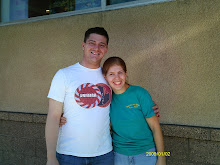
Tonight as I was coming home, I remembered the vase I had bought for Jack Teacher's flowers. It had been sitting empty on my refrigerator for a week and I was in need of something pretty to fill it. Inspired by Jack's gesture, over the last month I have begun keeping a fresh supply of arrangements in the apartment. I usually don't spend very much on them, sam chon won (3,000 won, or $2.60) at most--just something simple, homey, and "everyday." They provide a much-needed reminder of the beauty and serenity of God's natural world amid the city's hectic schedules and stuffy concrete enclosures. Even Frankie enjoys it when I bring a fresh batch home, as he gets to inhale the scent of adventure and the longed-for outdoors once again.
As a consequence of my indulgence, I have also been sampling the different mom-and-pop florists around me. I've been to a shop about two blocks from my house, one at the nearby train station, and a few days ago I stumbled upon one off the main road that I have yet to visit. Most of the shops can be identified--for those of us whose skill at reading hangul leaves a bit to be desired--by the profusion of plant life which litters their entrances and the sidewalks in front of them. Stepping inside, one notes that they each offer much the same merchandise at much the same price: larger potted plants like orchids or bamboo for sah man or oh man won ($45); tiny, rubbery plants or cacti for oh chon won ($4.50); and cut flower arrangements of varying sizes and prices.
One such store lies just inside the Lotte Cinema intersection, the centerpiece of a bustling restaurant and entertainment district. As I passed by it tonight, I decided to have a look. Once inside, I walked the few steps towards the green buckets on the floor containing water and the stems of various types of flowers. I noted four different colors of rose--red, hot pink, yellow, and
a paler pink--as well as two or three other less-identifiable blossoms. A thick bunch of bright yellow petals, which looked like they could be miniature sunflowers, sat in a bucket at the back of the group.
The florist's workstation rested against the side wall of the store and stood mere inches from the fresh flower pots, ready for quick arrangements with its rolls of paper, green wire, and ribbon dangling within arms' reach. A woman stood in front of the table manning the shop. I pointed to the pale pink roses. "Igo mohyo?" I asked. How much?
She picked up an entire bunch and held it a little out of the water. "Man won." Ten thousand.
I considered them for a moment; I hadn't wanted to spend that much. I pointed to the yellow ones in the back. "Igo?" I asked.
"Pal chon." My eyes lit up. I pointed to the yellow and bright pink roses. Chon won each, she said. One thousand. I could buy the yellow ones, throw in a rose or two, and still be under five thousand won--sweet!
"Igo chuseyo," I commanded politely, indicating the yellow petals. Those please. She looked at me and asked if I wanted anything else. "Igo" --I pointed to the yellow rose-- "hago igo." And this, the bright pink one.
I was a bit mistaken about the price, however. As I considered the paler pink roses for inclusion in my arrangement, the florist looked at me. "Igo, man won," she said. All of this for ten thousand. And that's when I remembered--pal chon. That's right! Eight thousand! I was thinking eight hundred!
I considered what was in her hand, pointing to the yellow flowers. I thought about the poor vase waiting at home and how it could hold such a cacophony of vegetation. "Igo, chogum?" I asked timidly. Can I have a little? She shook her head; they were sold together, as one bunch. I shrugged. They were pretty. Perhaps my vase would be big enough. There went my household budget for the week, then.
The florist looked at me again and asked something in Korean. I thought she was asking if I wanted to take them home. "Ne," I affirmed as I held out my green man-won bill. Yes, I would love to. I watched as she snipped the stems, patted them dry, and twisted wire around them to make a tight bundle. I assumed she'd soon roll the flowers in a bit of plastic and I expected her to hand them over at any moment, but she kept right on working. Intrigued, I kept watching.
I saw her reach for one and then a second roll of textured material, one a gauzy netting and the other traditional-type paper wrapping. She bunched the white netting in an appealing maze of twists and hoops close toward the petals, securing it with wire; I thought that was pretty enough. She then took the ivory paper and wrapped it around the entire arrangement, forming a bouquet as it flared out over the buds. I noted her pulling meters of wide flowery-gold ribbon from its spool and looping it over and over to form a bunchy bow, which she secured at the base of the flare. As the finishing touch, she sprayed the roses with a dew-like liquid and dusted the petals with shiny, gold glitter.
I felt like a bride as she handed me the finished bouquet, in awe of her talent as an artist. I could have just come from a wedding, I thought, as I walked down the street toward my apartment. Had I understood what she was saying, I probably wouldn't have asked for such an elaborate floral display. It was, however, a pleasant surprise. I suppose there are, indeed, some benefits to the language barrier after all.




I enjoyed reading!
ReplyDeleteyour korean is good!
대단하세요-De Dan Ha Se Yo (you are great!)
And also, your flower is beautiful!